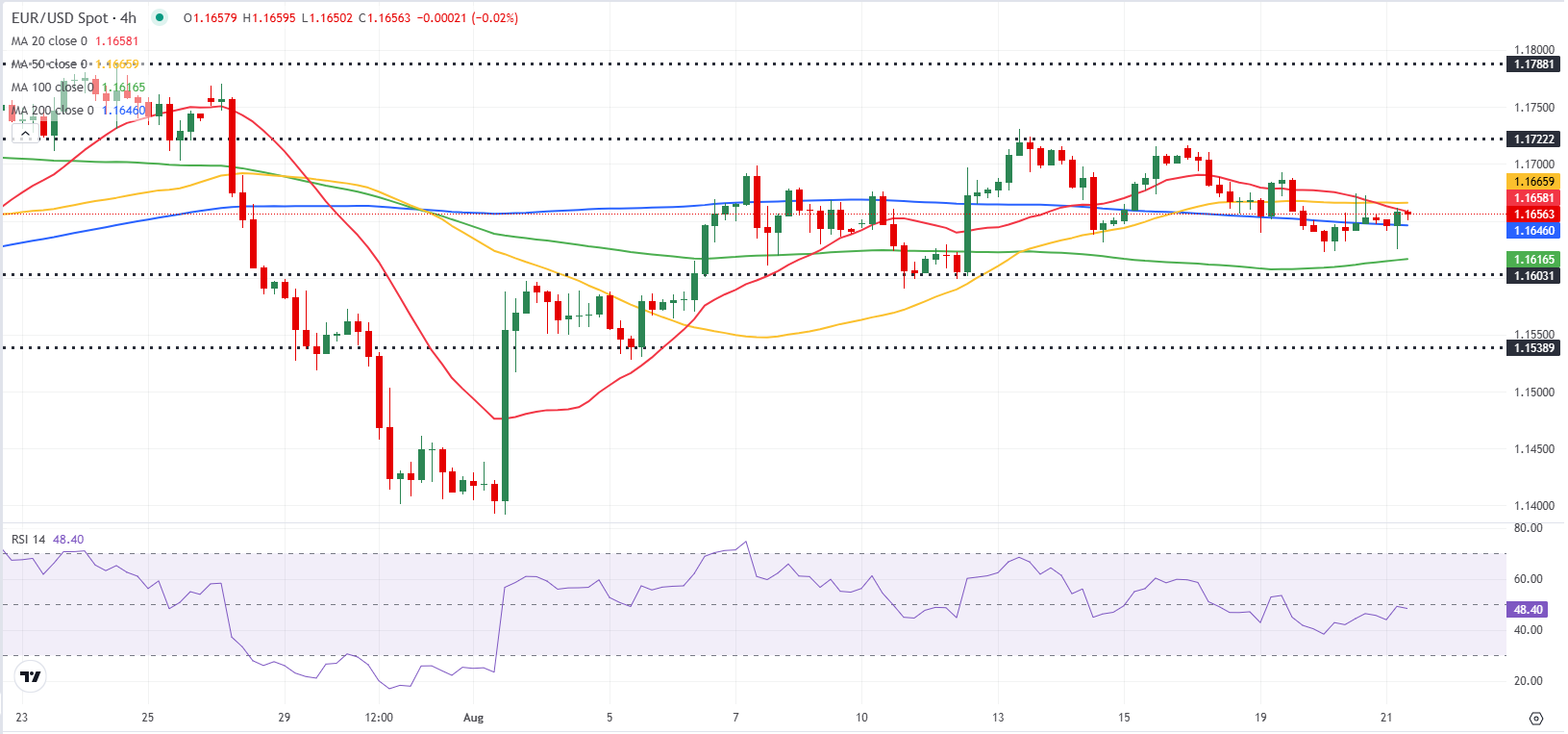
- EUR/USD recovers to the 1.1650 region following an earlier decline.
- The Euro holds ground following the Germany and EU PMI releases.
- Market focus shift to Jobless Claims and PMI data from the US.
EUR/USD holds steady at around 1.1650 after starting the day under bearish pressure, as the Euro benefits from the Purchasing Managers’ Index (PMI) data releases from Germany and the Eurozone. In the second half of the day, Jobless Claims and PMI data from the US will be watched closely by market participants.
Euro Price This week
The table below shows the percentage change of Euro (EUR) against listed major currencies this week. Euro was the weakest against the Swiss Franc.
| USD | EUR | GBP | JPY | CAD | AUD | NZD | CHF | |
|---|---|---|---|---|---|---|---|---|
| USD | 0.49% | 0.64% | 0.30% | 0.45% | 1.36% | 1.77% | -0.05% | |
| EUR | -0.49% | 0.15% | -0.21% | -0.04% | 0.89% | 1.24% | -0.53% | |
| GBP | -0.64% | -0.15% | -0.44% | -0.19% | 0.73% | 1.08% | -0.73% | |
| JPY | -0.30% | 0.21% | 0.44% | 0.18% | 1.09% | 1.49% | -0.34% | |
| CAD | -0.45% | 0.04% | 0.19% | -0.18% | 0.89% | 1.30% | -0.54% | |
| AUD | -1.36% | -0.89% | -0.73% | -1.09% | -0.89% | 0.35% | -1.45% | |
| NZD | -1.77% | -1.24% | -1.08% | -1.49% | -1.30% | -0.35% | -1.81% | |
| CHF | 0.05% | 0.53% | 0.73% | 0.34% | 0.54% | 1.45% | 1.81% |
The heat map shows percentage changes of major currencies against each other. The base currency is picked from the left column, while the quote currency is picked from the top row. For example, if you pick the Euro from the left column and move along the horizontal line to the US Dollar, the percentage change displayed in the box will represent EUR (base)/USD (quote).
The risk-averse market atmosphere helped the US Dollar (USD) hold its ground early Thursday and caused EUR/USD to stretch lower.
In the European session, the data from Germany and the Eurozone both showed that the business activity in the private sector expanded at a faster pace in early August than they did in July, supporting the Euro. HCOB Composite PMI rose to 50.9 and 51.1 in Germany and the Eurozone, respectively.
Commenting on the survey’s findings, “the European Central Bank might wince a little at the rising cost pressures in the services sector,” said Dr. Cyrus de la Rubia, Chief Economist at Hamburg Commercial Bank. “After all, it’s banking on slower wage growth to help bring inflation down in this crucial part of the economy. That said, there’s a bit of relief in the fact that inflation in service-sector selling prices has remained more or less steady.”
The number of first-time applications for unemployment benefits in the US is expected to tick up to 225K from 224K in the previous week. A noticeable decline in this data could support the USD with the immediate reaction.
Later in the day, S&P Global Manufacturing PMI is forecast to edge lower to 49.5 in August’s preliminary estimate, while the Services PMI is seen retreating to 54.2. In case both PMIs come in worse than analysts’ estimates, the USD could come under bearish pressure. If they remain close to July prints or market expectations, commentary on the employment and inflation situation could drive the USD’s action. In case the survey paints a gloomy picture about private sector payrolls, the USD could have a hard time finding demand. Conversely, the currency could gather strength if there is a meaningful increase in input inflation, especially in the service sector.
EUR/USD Technical Analysis

The Relative Strength Index (RSI) indicator on the 4-hour chart moves sideways slightly below 50, highlighting a lack of buyer interest. The 200-period Simple Moving Average (SMA), and the 50-day SMA form a key technical level at 1.1650. Once this level is confirmed as support, 1.1720 (static level), 1.1760 (static level) and 1.1800 (static level, round level) could be seen as next resistance levels.
On the downside, 1.1610-1.1600 (100-period SMA, round level) could be seen as an interim support level before 1.1540 (static level) and 1.1500 (static level, round level), if EUR/USD retreats below 1.1650 and starts using this level as resistance.
Euro FAQs
The Euro is the currency for the 19 European Union countries that belong to the Eurozone. It is the second most heavily traded currency in the world behind the US Dollar. In 2022, it accounted for 31% of all foreign exchange transactions, with an average daily turnover of over $2.2 trillion a day. EUR/USD is the most heavily traded currency pair in the world, accounting for an estimated 30% off all transactions, followed by EUR/JPY (4%), EUR/GBP (3%) and EUR/AUD (2%).
The European Central Bank (ECB) in Frankfurt, Germany, is the reserve bank for the Eurozone. The ECB sets interest rates and manages monetary policy. The ECB’s primary mandate is to maintain price stability, which means either controlling inflation or stimulating growth. Its primary tool is the raising or lowering of interest rates. Relatively high interest rates – or the expectation of higher rates – will usually benefit the Euro and vice versa. The ECB Governing Council makes monetary policy decisions at meetings held eight times a year. Decisions are made by heads of the Eurozone national banks and six permanent members, including the President of the ECB, Christine Lagarde.
Eurozone inflation data, measured by the Harmonized Index of Consumer Prices (HICP), is an important econometric for the Euro. If inflation rises more than expected, especially if above the ECB’s 2% target, it obliges the ECB to raise interest rates to bring it back under control. Relatively high interest rates compared to its counterparts will usually benefit the Euro, as it makes the region more attractive as a place for global investors to park their money.
Data releases gauge the health of the economy and can impact on the Euro. Indicators such as GDP, Manufacturing and Services PMIs, employment, and consumer sentiment surveys can all influence the direction of the single currency. A strong economy is good for the Euro. Not only does it attract more foreign investment but it may encourage the ECB to put up interest rates, which will directly strengthen the Euro. Otherwise, if economic data is weak, the Euro is likely to fall. Economic data for the four largest economies in the euro area (Germany, France, Italy and Spain) are especially significant, as they account for 75% of the Eurozone’s economy.
Another significant data release for the Euro is the Trade Balance. This indicator measures the difference between what a country earns from its exports and what it spends on imports over a given period. If a country produces highly sought after exports then its currency will gain in value purely from the extra demand created from foreign buyers seeking to purchase these goods. Therefore, a positive net Trade Balance strengthens a currency and vice versa for a negative balance.
Information on these pages contains forward-looking statements that involve risks and uncertainties. Markets and instruments profiled on this page are for informational purposes only and should not in any way come across as a recommendation to buy or sell in these assets. You should do your own thorough research before making any investment decisions. FXStreet does not in any way guarantee that this information is free from mistakes, errors, or material misstatements. It also does not guarantee that this information is of a timely nature. Investing in Open Markets involves a great deal of risk, including the loss of all or a portion of your investment, as well as emotional distress. All risks, losses and costs associated with investing, including total loss of principal, are your responsibility. The views and opinions expressed in this article are those of the authors and do not necessarily reflect the official policy or position of FXStreet nor its advertisers. The author will not be held responsible for information that is found at the end of links posted on this page.
If not otherwise explicitly mentioned in the body of the article, at the time of writing, the author has no position in any stock mentioned in this article and no business relationship with any company mentioned. The author has not received compensation for writing this article, other than from FXStreet.
FXStreet and the author do not provide personalized recommendations. The author makes no representations as to the accuracy, completeness, or suitability of this information. FXStreet and the author will not be liable for any errors, omissions or any losses, injuries or damages arising from this information and its display or use. Errors and omissions excepted.
The author and FXStreet are not registered investment advisors and nothing in this article is intended to be investment advice.




